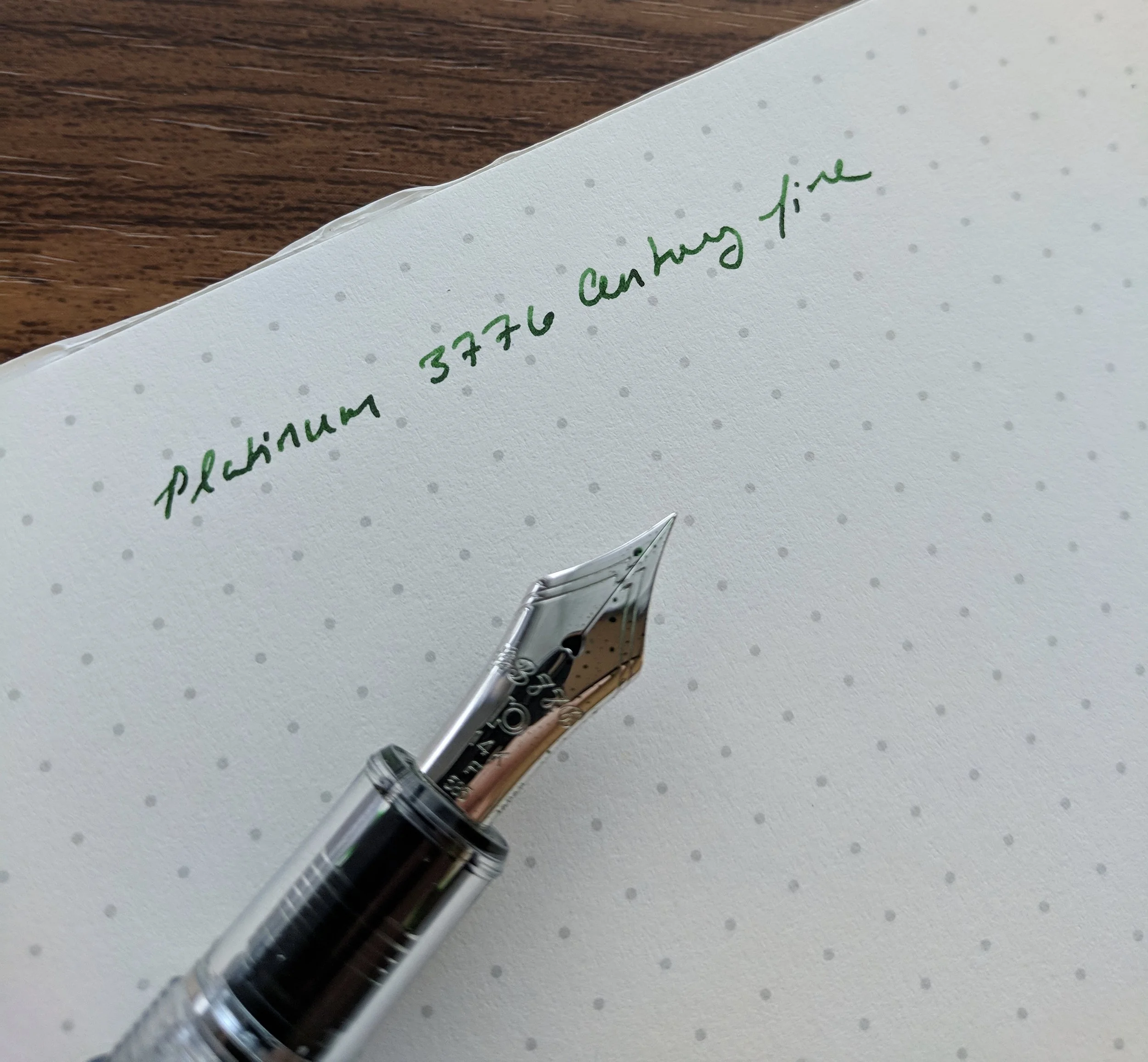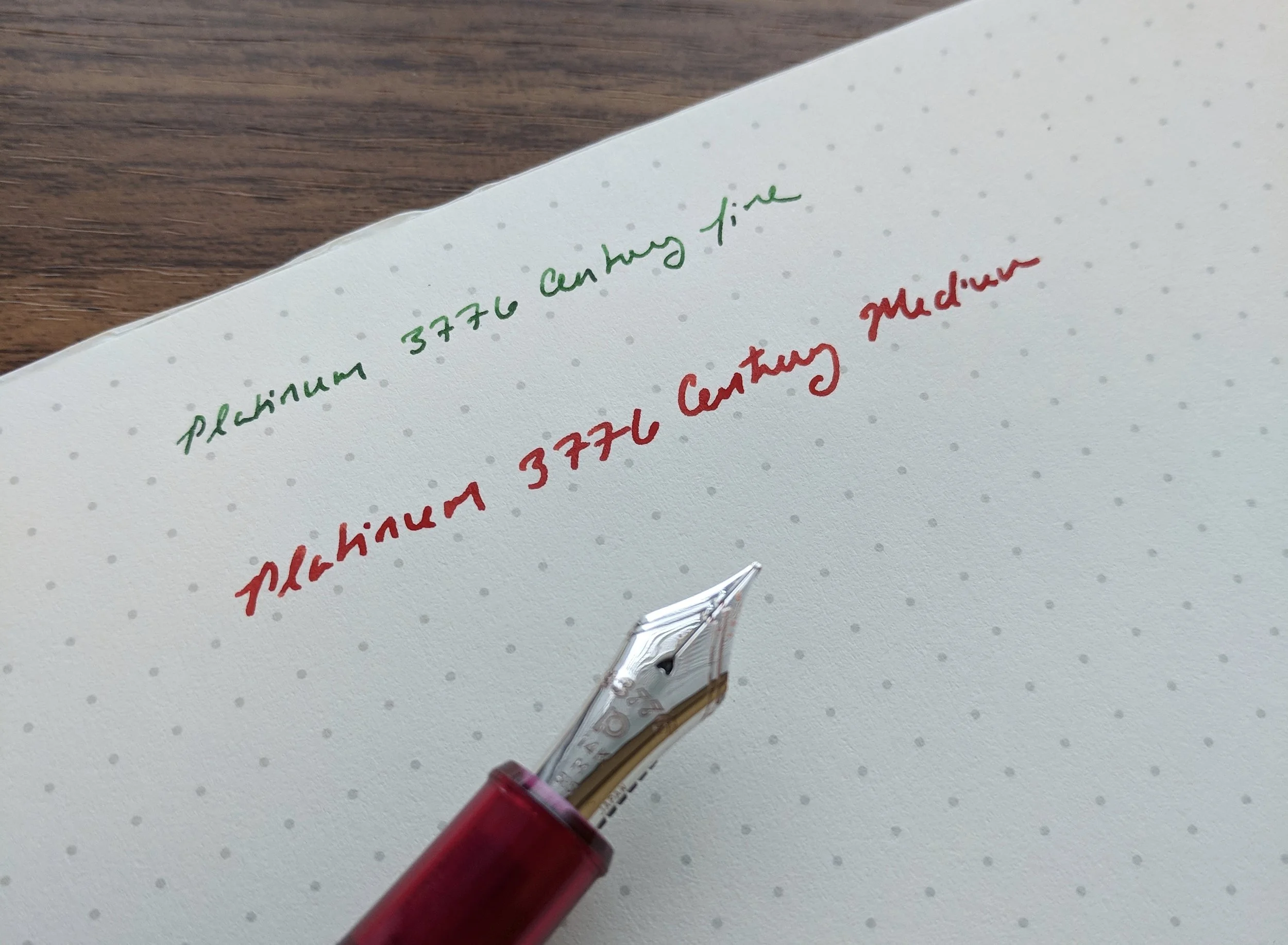Now that this blog is more than four years old, I’ve come to a point where I can start revisiting pens I reviewed in the “early days,” such as the Platinum 3776 “Century”. I previously reviewed the standard models of the Platinum 3776 Century back in 2016, and my overall impressions from that review still hold true. Moreover, Platinum has dropped the U.S. price of the standard 3776 to a more competitive price point that hovers in the $150 range, depending on where you shop and the availability of store-specific discount codes.
The Shungyo limited edition in my favorite color (red!) on the left, and the crystal clear Oshino demonstrator on the right.
Since that review, however, my personal collecting has focused more on the special and limited edition 3776 models, particularly the “Mt. Fuji” series of limited editions. I have two of these pens, pictured here: The “Shungyo” Limited Edition, which is part of the "Fuji Shunkei” (seasonal) series where the pens are inspired by seasonal views of Mt. Fuji; and the “Oshino” Limited Edition, named for the Oshino Hakkai spring under Mount Fuji. (You may have also seen pictures of the recent Kumpoo (“Balmy Breeze”) model, which I passed on because the color just isn’t my thing - not necessarily because of the somewhat cringe-inducing name.
Unlike the standard Mt. Fuji special editions, the Fuji Shunkei editions have added texture on the body. While my Oshino demonstrator is completely smooth, the Shungyo pictured here features lightly etched lines, which I find relatively subtle. The texture on the recent Kumpoo limited edition is more pronounced.
So why do I enjoy this pen so much? Like other favorites such as the Parker Sonnet, the Pelikan M400/M600, and the Montblanc Meisterstuck Classique, the 3776 Century is a perfect size for me, especially when posted. It’s a touch larger than the Sonnet, but smaller than the Montblanc 146. And the fact that the Platinum 3776 features a cartridge-converter filling system means that it’s extremely lightweight. These pens are made to write, and perfect for long workdays.
The Platinum 3776 is an ideal size and weight for me posted. I rarely use this pen unposted, but I’ve added a picture below to give a sense of the size.
Note: Though not something I focus on, since I tend to use my pens pretty extensively and it would be nearly impossible for me to let a pen sit this long, all Platinum 3776 “Century” pens feature Platinum’s “Slip and Seal” cap, which supposedly prevents the ink from drying out in the nib for 24 months. (I say “supposedly” only because I’ve never tested it nor do I have any intention of doing so - I have no reason to believe that Platinum’s claim is inaccurate.)
Oddly enough, the only problems I’ve experienced have been with the nibs - supposedly Platinum’s strong point. Both the UEF (“ultra extra fine”) nib on my Chartres Blue demonstrator and the fine nib on my Oshino wrote extremely dry out of the box, and needed to be adjusted. I’ve heard mixed reports from other people. Some nibs apparently write perfectly, others have the same issue that I did. I’m not sure whether it’s a quality control problem, or that my writing style might be incompatible with how Platinum’s standard fine nibs are tuned. On the other hand, the medium nib on my Shungyo wrote flawlessly out of the box.
Takeaways and Where to Buy
Though Platinum still receives less acclaim in the broader pen community than its “sibling brand” Nakaya, Platinum pens feature essentially the same nibs and offer a compelling value proposition on both their standard and “special edition” pens. They’ve also become more widely available in recent years, with most major pen retailers stocking Platinum and receiving an allocation of the latest limited and special editions. I purchased both pens pictured here from site sponsor Pen Chalet.
The Oshino demonstrator is still available, and currently on sale at a very attractive price. The Shungyo Pen, however, has been sold out for quite some time in regular retail channels, but they still come up occasionally on Amazon. They are starting to appear less frequently as several new models have come and gone since the Shungyo’s original release.
Disclaimer: This post contains links to paid sponsors and affiliates. I purchased both pens featured in this review using store credit from Pen Chalet that I earned through their affiliate program.



